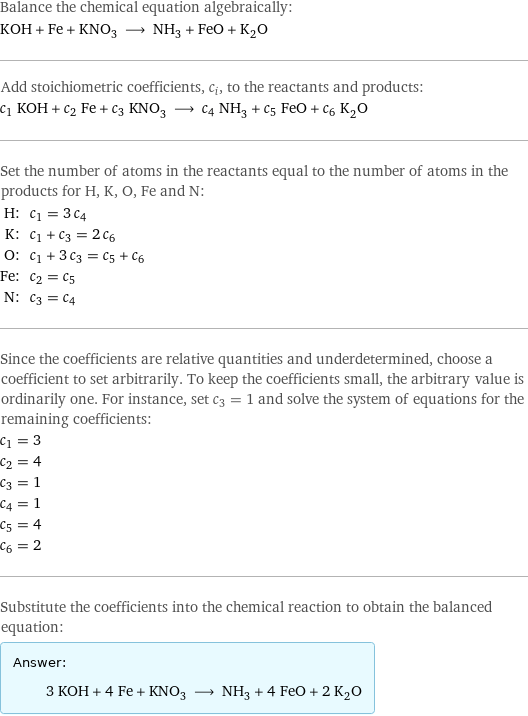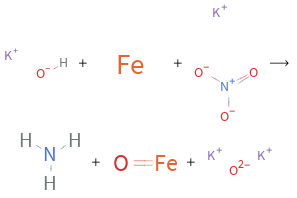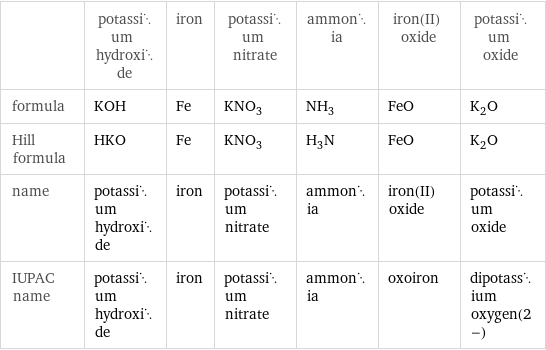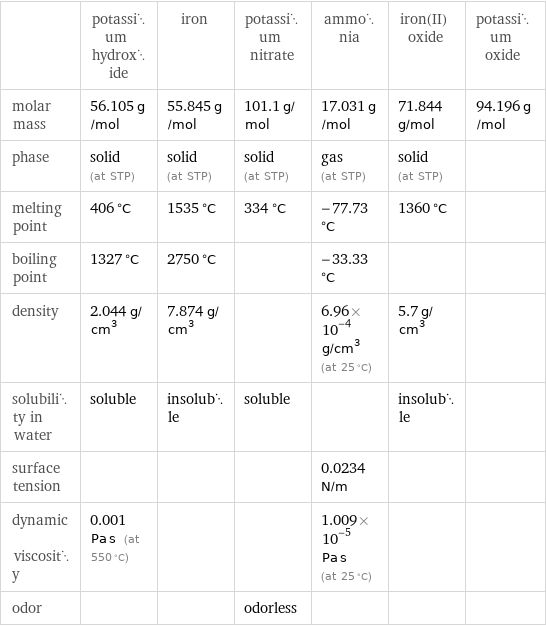Input interpretation

KOH potassium hydroxide + Fe iron + KNO_3 potassium nitrate ⟶ NH_3 ammonia + FeO iron(II) oxide + K_2O potassium oxide
Balanced equation

Balance the chemical equation algebraically: KOH + Fe + KNO_3 ⟶ NH_3 + FeO + K_2O Add stoichiometric coefficients, c_i, to the reactants and products: c_1 KOH + c_2 Fe + c_3 KNO_3 ⟶ c_4 NH_3 + c_5 FeO + c_6 K_2O Set the number of atoms in the reactants equal to the number of atoms in the products for H, K, O, Fe and N: H: | c_1 = 3 c_4 K: | c_1 + c_3 = 2 c_6 O: | c_1 + 3 c_3 = c_5 + c_6 Fe: | c_2 = c_5 N: | c_3 = c_4 Since the coefficients are relative quantities and underdetermined, choose a coefficient to set arbitrarily. To keep the coefficients small, the arbitrary value is ordinarily one. For instance, set c_3 = 1 and solve the system of equations for the remaining coefficients: c_1 = 3 c_2 = 4 c_3 = 1 c_4 = 1 c_5 = 4 c_6 = 2 Substitute the coefficients into the chemical reaction to obtain the balanced equation: Answer: | | 3 KOH + 4 Fe + KNO_3 ⟶ NH_3 + 4 FeO + 2 K_2O
Structures

+ + ⟶ + +
Names

potassium hydroxide + iron + potassium nitrate ⟶ ammonia + iron(II) oxide + potassium oxide
Equilibrium constant
![Construct the equilibrium constant, K, expression for: KOH + Fe + KNO_3 ⟶ NH_3 + FeO + K_2O Plan: • Balance the chemical equation. • Determine the stoichiometric numbers. • Assemble the activity expression for each chemical species. • Use the activity expressions to build the equilibrium constant expression. Write the balanced chemical equation: 3 KOH + 4 Fe + KNO_3 ⟶ NH_3 + 4 FeO + 2 K_2O Assign stoichiometric numbers, ν_i, using the stoichiometric coefficients, c_i, from the balanced chemical equation in the following manner: ν_i = -c_i for reactants and ν_i = c_i for products: chemical species | c_i | ν_i KOH | 3 | -3 Fe | 4 | -4 KNO_3 | 1 | -1 NH_3 | 1 | 1 FeO | 4 | 4 K_2O | 2 | 2 Assemble the activity expressions accounting for the state of matter and ν_i: chemical species | c_i | ν_i | activity expression KOH | 3 | -3 | ([KOH])^(-3) Fe | 4 | -4 | ([Fe])^(-4) KNO_3 | 1 | -1 | ([KNO3])^(-1) NH_3 | 1 | 1 | [NH3] FeO | 4 | 4 | ([FeO])^4 K_2O | 2 | 2 | ([K2O])^2 The equilibrium constant symbol in the concentration basis is: K_c Mulitply the activity expressions to arrive at the K_c expression: Answer: | | K_c = ([KOH])^(-3) ([Fe])^(-4) ([KNO3])^(-1) [NH3] ([FeO])^4 ([K2O])^2 = ([NH3] ([FeO])^4 ([K2O])^2)/(([KOH])^3 ([Fe])^4 [KNO3])](../image_source/3d0d8cc0941355ae257fa0c4ed2709a5.png)
Construct the equilibrium constant, K, expression for: KOH + Fe + KNO_3 ⟶ NH_3 + FeO + K_2O Plan: • Balance the chemical equation. • Determine the stoichiometric numbers. • Assemble the activity expression for each chemical species. • Use the activity expressions to build the equilibrium constant expression. Write the balanced chemical equation: 3 KOH + 4 Fe + KNO_3 ⟶ NH_3 + 4 FeO + 2 K_2O Assign stoichiometric numbers, ν_i, using the stoichiometric coefficients, c_i, from the balanced chemical equation in the following manner: ν_i = -c_i for reactants and ν_i = c_i for products: chemical species | c_i | ν_i KOH | 3 | -3 Fe | 4 | -4 KNO_3 | 1 | -1 NH_3 | 1 | 1 FeO | 4 | 4 K_2O | 2 | 2 Assemble the activity expressions accounting for the state of matter and ν_i: chemical species | c_i | ν_i | activity expression KOH | 3 | -3 | ([KOH])^(-3) Fe | 4 | -4 | ([Fe])^(-4) KNO_3 | 1 | -1 | ([KNO3])^(-1) NH_3 | 1 | 1 | [NH3] FeO | 4 | 4 | ([FeO])^4 K_2O | 2 | 2 | ([K2O])^2 The equilibrium constant symbol in the concentration basis is: K_c Mulitply the activity expressions to arrive at the K_c expression: Answer: | | K_c = ([KOH])^(-3) ([Fe])^(-4) ([KNO3])^(-1) [NH3] ([FeO])^4 ([K2O])^2 = ([NH3] ([FeO])^4 ([K2O])^2)/(([KOH])^3 ([Fe])^4 [KNO3])
Rate of reaction
![Construct the rate of reaction expression for: KOH + Fe + KNO_3 ⟶ NH_3 + FeO + K_2O Plan: • Balance the chemical equation. • Determine the stoichiometric numbers. • Assemble the rate term for each chemical species. • Write the rate of reaction expression. Write the balanced chemical equation: 3 KOH + 4 Fe + KNO_3 ⟶ NH_3 + 4 FeO + 2 K_2O Assign stoichiometric numbers, ν_i, using the stoichiometric coefficients, c_i, from the balanced chemical equation in the following manner: ν_i = -c_i for reactants and ν_i = c_i for products: chemical species | c_i | ν_i KOH | 3 | -3 Fe | 4 | -4 KNO_3 | 1 | -1 NH_3 | 1 | 1 FeO | 4 | 4 K_2O | 2 | 2 The rate term for each chemical species, B_i, is 1/ν_i(Δ[B_i])/(Δt) where [B_i] is the amount concentration and t is time: chemical species | c_i | ν_i | rate term KOH | 3 | -3 | -1/3 (Δ[KOH])/(Δt) Fe | 4 | -4 | -1/4 (Δ[Fe])/(Δt) KNO_3 | 1 | -1 | -(Δ[KNO3])/(Δt) NH_3 | 1 | 1 | (Δ[NH3])/(Δt) FeO | 4 | 4 | 1/4 (Δ[FeO])/(Δt) K_2O | 2 | 2 | 1/2 (Δ[K2O])/(Δt) (for infinitesimal rate of change, replace Δ with d) Set the rate terms equal to each other to arrive at the rate expression: Answer: | | rate = -1/3 (Δ[KOH])/(Δt) = -1/4 (Δ[Fe])/(Δt) = -(Δ[KNO3])/(Δt) = (Δ[NH3])/(Δt) = 1/4 (Δ[FeO])/(Δt) = 1/2 (Δ[K2O])/(Δt) (assuming constant volume and no accumulation of intermediates or side products)](../image_source/38af2f9d3db8fb121663ed0df43f88a1.png)
Construct the rate of reaction expression for: KOH + Fe + KNO_3 ⟶ NH_3 + FeO + K_2O Plan: • Balance the chemical equation. • Determine the stoichiometric numbers. • Assemble the rate term for each chemical species. • Write the rate of reaction expression. Write the balanced chemical equation: 3 KOH + 4 Fe + KNO_3 ⟶ NH_3 + 4 FeO + 2 K_2O Assign stoichiometric numbers, ν_i, using the stoichiometric coefficients, c_i, from the balanced chemical equation in the following manner: ν_i = -c_i for reactants and ν_i = c_i for products: chemical species | c_i | ν_i KOH | 3 | -3 Fe | 4 | -4 KNO_3 | 1 | -1 NH_3 | 1 | 1 FeO | 4 | 4 K_2O | 2 | 2 The rate term for each chemical species, B_i, is 1/ν_i(Δ[B_i])/(Δt) where [B_i] is the amount concentration and t is time: chemical species | c_i | ν_i | rate term KOH | 3 | -3 | -1/3 (Δ[KOH])/(Δt) Fe | 4 | -4 | -1/4 (Δ[Fe])/(Δt) KNO_3 | 1 | -1 | -(Δ[KNO3])/(Δt) NH_3 | 1 | 1 | (Δ[NH3])/(Δt) FeO | 4 | 4 | 1/4 (Δ[FeO])/(Δt) K_2O | 2 | 2 | 1/2 (Δ[K2O])/(Δt) (for infinitesimal rate of change, replace Δ with d) Set the rate terms equal to each other to arrive at the rate expression: Answer: | | rate = -1/3 (Δ[KOH])/(Δt) = -1/4 (Δ[Fe])/(Δt) = -(Δ[KNO3])/(Δt) = (Δ[NH3])/(Δt) = 1/4 (Δ[FeO])/(Δt) = 1/2 (Δ[K2O])/(Δt) (assuming constant volume and no accumulation of intermediates or side products)
Chemical names and formulas

| potassium hydroxide | iron | potassium nitrate | ammonia | iron(II) oxide | potassium oxide formula | KOH | Fe | KNO_3 | NH_3 | FeO | K_2O Hill formula | HKO | Fe | KNO_3 | H_3N | FeO | K_2O name | potassium hydroxide | iron | potassium nitrate | ammonia | iron(II) oxide | potassium oxide IUPAC name | potassium hydroxide | iron | potassium nitrate | ammonia | oxoiron | dipotassium oxygen(2-)
Substance properties

| potassium hydroxide | iron | potassium nitrate | ammonia | iron(II) oxide | potassium oxide molar mass | 56.105 g/mol | 55.845 g/mol | 101.1 g/mol | 17.031 g/mol | 71.844 g/mol | 94.196 g/mol phase | solid (at STP) | solid (at STP) | solid (at STP) | gas (at STP) | solid (at STP) | melting point | 406 °C | 1535 °C | 334 °C | -77.73 °C | 1360 °C | boiling point | 1327 °C | 2750 °C | | -33.33 °C | | density | 2.044 g/cm^3 | 7.874 g/cm^3 | | 6.96×10^-4 g/cm^3 (at 25 °C) | 5.7 g/cm^3 | solubility in water | soluble | insoluble | soluble | | insoluble | surface tension | | | | 0.0234 N/m | | dynamic viscosity | 0.001 Pa s (at 550 °C) | | | 1.009×10^-5 Pa s (at 25 °C) | | odor | | | odorless | | |
Units
